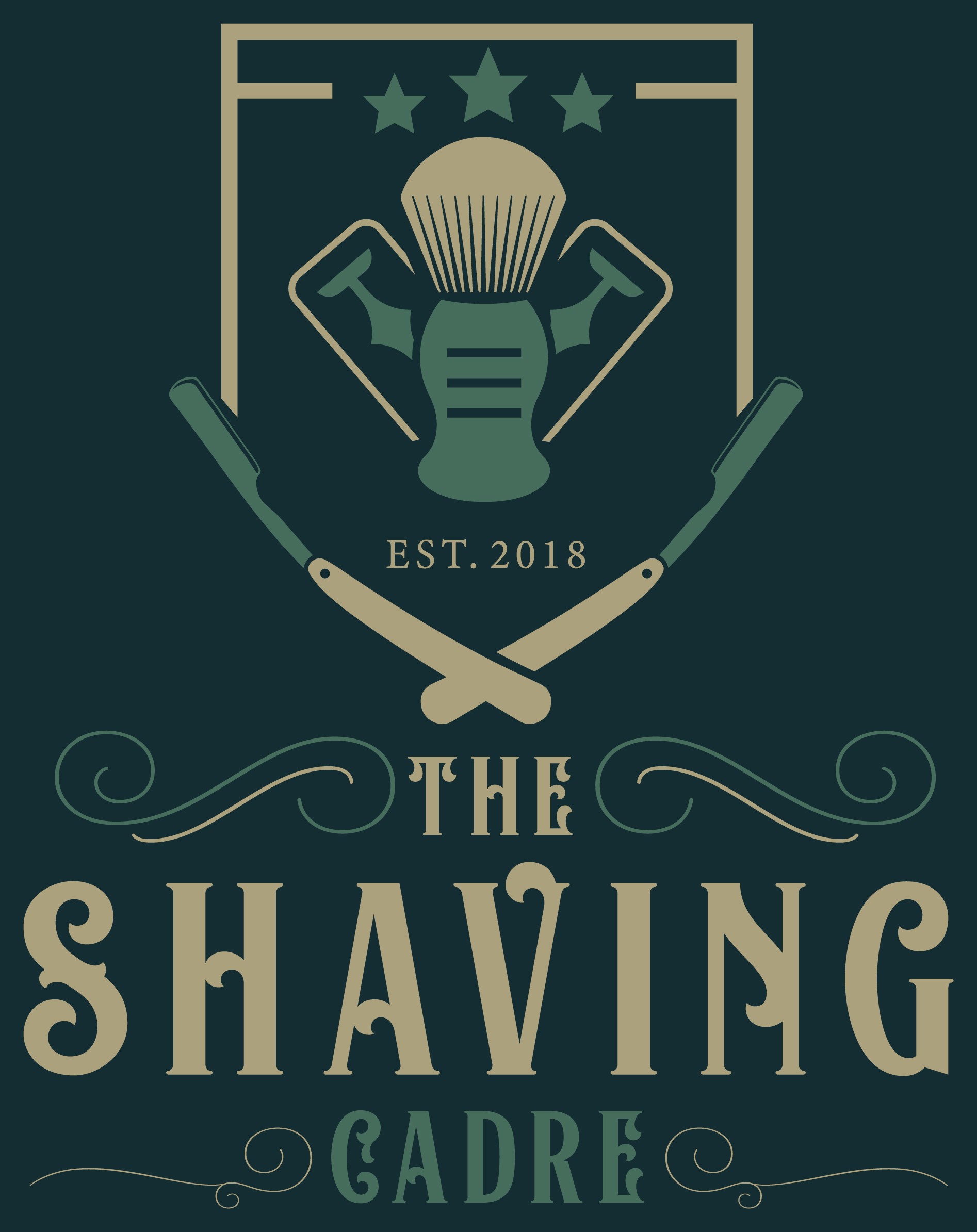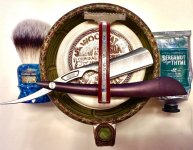Whenever I read your posts I feel like a student sitting down to listen to an enjoyable professor. Please keep posting, Jeff. You are a welcome addition here.
The Shaving Cadre
You are using an out of date browser. It may not display this or other websites correctly.
You should upgrade or use an alternative browser.
You should upgrade or use an alternative browser.
Natterings of a Nasal Barbarian
- Thread starter jgreenepa
- Start date
jgreenepa
TSC's "Velveteen Shaver"
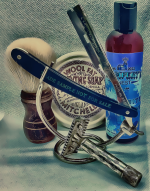
SOTD MONDAY MORNING, MAY 16, 2022
Edward Weck emigrated from Solingen, Germany and opened his cutlery company showroom in 1890 in Manhattan, with manufacturing facilities in Brooklyn.
According to “Brownstoner”,
“Weck invented the precursor of the multi-blade razor, and patented it in 1909.”
[n.b. Incorrect!! In actuality, they’d been around quite awhile. Antoinne LeCoultre invented the first replaceable blade razor in 1830, 79 yrs earlier]
“It was called the Weck Sextoblade. The “sex” in “sextoblade” for all those whose imaginations just woke up, meant “six.” Sorry! Weck’s razor came with six blades all attached at the base, able to be folded back into the handle and secured by a safety guard. Each blade could be extended when needed, and if all were stropped and sharpened at once, this razor could last a long time before the next sharpening. For its day, it was quite revolutionary.”
In 1917 he incorporated under the name ‘Edward Weck & Son’, finally passing away from heart disease in 1922. His son, Albert, moved the company into surgical instruments, made for both the military and medical community. The company continued until 1999 when it was acquired by Squibb. Today’s mug shave featured my Weck Sextoblade. The razor came from the estate of a third party beauty/shaving supplies salesman and former barber, according to his great-granddaughter.
My first shave with it featured a newly purchased Personna hair shaper blade, however, I noticed that the spine appeared to have a fair bit of hone wear. From the deep grooves observed, I would suspect the rather rough use of a Diamond plate. In any case, I removed and soaked the original Sextoblade blade that arrived with the razor in barbicide when it first arrived about 7 months ago, That morning I ran it across my Swaty barber’s hone with some Smith’s Honing oil, after placing it back in the razor, until the edge looked good under my USB microscope.
I believe that the original blade had never been removed, as I was unable to remove it with my fingers when it first arrived, and needed a needle nose pliers to do so. Judging by the amount of shave residue on the original Sextoblade blade coupled with the hone wear on the spine, I believe the former owner treated it just like a regular straight and never removed it from the razor. In fact the original blade looks like it is double beveled. The shave angle on this old antique tool is virtually identical to the angle I use with my regular straight razors. My new Koenig barber’s hone and a little shave cream polished up the blade nicely. The two and a half pass mug shave with it that followed this morning was excellent leaving me smooth as a peach.
Unlike many of my shave brothers and sisters out there, I’ve never been a fan of Gillette TTO’s. I do own a few, but have been selling all but my father’s and grandfather’s safety razors. My father owned two Gillette adjustables, a Gold Black Beauty long handled adjustable and a Slim. My grandfather shaved with an old beat up single ring from a WWI military khaki kit that I also have. The only Gillettes that really ring my chimes, however, are any of the second generation ‘New’ models. So this morning I grabbed my silver plated Gillette New Standard/Bostonian, loaded a fresh Feather blade and had at my noggin stubble! Two delightful ATG passes later and your happy narrator was smooth as a peach from noggin to neck.
RAZOR: Weck Sextoblade (Mug), Gillette New Standard/Bostonian (Dome)
BLADE: Feather DE (Dome)
PREP: Cold water rinse followed by a heavy scrub with Argan Oil
BRUSH: JR LE #374 Cashmere Synth
SOAP: Mitchell’s Wool Fat
POSTSHAVE: Cold water wash with brush squeezings followed by a rinse with Humphreys Lilac WH. Finished with Krampert’s Frostbite AS Splash.
The “sex” in “sextoblade” for all those whose imaginations just woke up, meant “six.” Sorry!

Great history on the Weck! Thanks!View attachment 83056
SOTD MONDAY MORNING, MAY 16, 2022
Edward Weck emigrated from Solingen, Germany and opened his cutlery company showroom in 1890 in Manhattan, with manufacturing facilities in Brooklyn.
According to “Brownstoner”,
“Weck invented the precursor of the multi-blade razor, and patented it in 1909.”
[n.b. Incorrect!! In actuality, they’d been around quite awhile. Antoinne LeCoultre invented the first replaceable blade razor in 1830, 79 yrs earlier]
“It was called the Weck Sextoblade. The “sex” in “sextoblade” for all those whose imaginations just woke up, meant “six.” Sorry! Weck’s razor came with six blades all attached at the base, able to be folded back into the handle and secured by a safety guard. Each blade could be extended when needed, and if all were stropped and sharpened at once, this razor could last a long time before the next sharpening. For its day, it was quite revolutionary.”
In 1917 he incorporated under the name ‘Edward Weck & Son’, finally passing away from heart disease in 1922. His son, Albert, moved the company into surgical instruments, made for both the military and medical community. The company continued until 1999 when it was acquired by Squibb. Today’s mug shave featured my Weck Sextoblade. The razor came from the estate of a third party beauty/shaving supplies salesman and former barber, according to his great-granddaughter.
My first shave with it featured a newly purchased Personna hair shaper blade, however, I noticed that the spine appeared to have a fair bit of hone wear. From the deep grooves observed, I would suspect the rather rough use of a Diamond plate. In any case, I removed and soaked the original Sextoblade blade that arrived with the razor in barbicide when it first arrived about 7 months ago, That morning I ran it across my Swaty barber’s hone with some Smith’s Honing oil, after placing it back in the razor, until the edge looked good under my USB microscope.
I believe that the original blade had never been removed, as I was unable to remove it with my fingers when it first arrived, and needed a needle nose pliers to do so. Judging by the amount of shave residue on the original Sextoblade blade coupled with the hone wear on the spine, I believe the former owner treated it just like a regular straight and never removed it from the razor. In fact the original blade looks like it is double beveled. The shave angle on this old antique tool is virtually identical to the angle I use with my regular straight razors. My new Koenig barber’s hone and a little shave cream polished up the blade nicely. The two and a half pass mug shave with it that followed this morning was excellent leaving me smooth as a peach.
Unlike many of my shave brothers and sisters out there, I’ve never been a fan of Gillette TTO’s. I do own a few, but have been selling all but my father’s and grandfather’s safety razors. My father owned two Gillette adjustables, a Gold Black Beauty long handled adjustable and a Slim. My grandfather shaved with an old beat up single ring from a WWI military khaki kit that I also have. The only Gillettes that really ring my chimes, however, are any of the second generation ‘New’ models. So this morning I grabbed my silver plated Gillette New Standard/Bostonian, loaded a fresh Feather blade and had at my noggin stubble! Two delightful ATG passes later and your happy narrator was smooth as a peach from noggin to neck.
RAZOR: Weck Sextoblade (Mug), Gillette New Standard/Bostonian (Dome)
BLADE: Feather DE (Dome)
PREP: Cold water rinse followed by a heavy scrub with Argan Oil
BRUSH: JR LE #374 Cashmere Synth
SOAP: Mitchell’s Wool Fat
POSTSHAVE: Cold water wash with brush squeezings followed by a rinse with Humphreys Lilac WH. Finished with Krampert’s Frostbite AS Splash.
jgreenepa
TSC's "Velveteen Shaver"
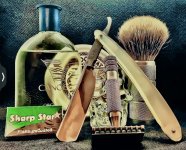
SOTD TUESDAY MORNING, MAY 17, 2022
This morning’s shave was close and comfortable. The mug shave featured the first Japanese razor I ever shaved with several years ago, the Tanifuji Airi 11/16 which started me down the Japanese razor rabbit hole. “Tanifuji Fukutaro”, born in 1894, was the first to start manufacturing western style Japanese straight razors. In 1918, he started his razor manufacturing company in Sumido-ku using Japanese traditional techniques and skills to build his razors with a large number of cutlery craftsman. His domestically produced western style razors using imported Swedish silver steel were perceived as sharper and superior to imported western style razors.
The manufacturing methods employed traditional Japanese sword-making technique and many of his blade shapes reflected this approach as my Tanifuji Airi razor does. Many well known Japanese razors like, Airi, Baba, Cape, Nichiri and Spalding to name a few were actually made by Mr. Tanifuji. With the rise of safety razor usage after WWII, he sold his blade manufacturing machinery to Mr. Iwasaki of Sanjo Works in the early 1950’s, although he continued to make the scales for all Iwasaki western razors until he retired in 1973. He passed away in 1990 at age 96.
The three pass mug shave this morning with my Tanifuji Airi 11/16, as my UK shave brother, Barry (@palmolive fox), would say, was “divine”. I also really enjoy my noggin shaves with the 2011 R41 which sits on a meaty Weber bulldog handle! The razor feels hefty and well balanced. Two ATG passes with a loaded Sharp Star blade left your happy narrator delightfully smooth from noggin to neck.
RAZOR: Tanifuji Airi 11/16 (Mug), 2011 Muhle R41 ( Dome)
BLADE: Sharp Star (Dome)
PREP: Cold water rinse followed by a heavy scrub with Argan Oil
BRUSH: MrEE LE #007 Knurled Aluminum Handled Hybrid Knot
SOAP: Mitchell’s Wool Fat
POSTSHAVE: Cold water wash with brush squeezings followed by a rinse with Humphreys WH. Finished with Canoe Original EdT Splash.
Awesome stuff! I have yet to pick up a single Japanese razor, sigh my collection is far from complete…
Thanks for the history lesson!
Thanks for the history lesson!
jgreenepa
TSC's "Velveteen Shaver"
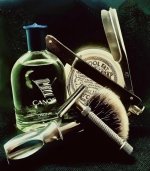
SOTD WEDNESDAY MORNING, MAY 18, 2022
This morning I shaved with the first LeCoultre replaceable blade Frameback I acquired. These razors have been mistakenly identified as French. They are actually Swiss, but from the French as opposed to the German part of Switzerland. The LeCoultre family, originally French, settled in Sentier, Switzerland in 1593. Their blacksmithing business got started about a century and a half later by Abraham Joseph I, born in 1711.
His grandson, Jacques, a blacksmith, along with his great grandson, Antoinne, a watchmaker started the replaceable blade straight razor business around 1830. Their unique contribution emerged out of their blacksmithing expertise, allowing for the consistent manufacture of very hard (Rockwell 64), replaceable, tempered steel blades for their razors. By the 1860’s the razors were marketed as luxury items with “blades only requiring sharpening every 10 years”, and were sold in jewelry and very high end cutlery merchants.
Honing them, as a result, turns out not to be a trivial endeavor. This first LeCoultre razor arrived shave ready, requiring only touchups. Honing my second LeCoultre after receiving sage honemeister guidance reminded me of my Klas Tornblom. Setting the bevel on that razor required almost twice the effort as a Sheffield or Solingen steel blade on my 1k Chosera. The resulting edge though was delightfully sharp and buttery smooth. Three slow pleasant mug passes with this first razor put the baby to bed, leaving yours truly velveteen smooth.
Adjustable safety razors, as it turns out are pretty much wasted on me. When I first acquired my Rex Ambassador three years ago, it had some issues. Fortunately, Matt Pisarcik truly does stand by his razors, and remedied the initial issues on his dime thanks to the generous guarantee that comes with every Rex razor. I realized early on in its use that I prefer shaving my dome with it wide open. It is without doubt one of my most efficient safety razors. The two pass ATG noggin shave following my mug endeavor left me velveteen smooth from noggin to neck.
RAZOR: LeCoultre Frameback with No. 2 blade (Mug), Rex Ambassador (Dome)
BLADE: Feather DE (Dome)
PREP: Cold water rinse followed by a heavy scrub with Argan Oil
BRUSH: Alpha Shaving T400 with 26mm Silvertip Badger Ferrule
SOAP: Mitchell’s Wool Fat
POSTSHAVE: Cold water wash with brush squeezings followed by a rinse with Humphreys WH. Finished with Canoe Original EdT AS Splash.
Great shave Jeff! Fascinating history of the razor - I enjoyed that
jgreenepa
TSC's "Velveteen Shaver"
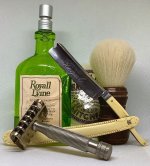
How nice to wake up to a bright sunny day! The bride and I will be meeting a Serbian friend, Mila, for a Farmer’s Market outing in Bucks County, Pa. about an hour away. Absolutely fabulous shave with my Wilbert Cutlery 9/16. Wilbert Cutlery was a house brand used by Sears Roebuck & Co. for their upscale knives and razors from 1908 - 1921. Sears developed a reputation for well-built quality tools that started with the Wilbert Cutlery brand and later transferred to the broader “Craftsmen” brand of tools which first appeared in their catalogue in 1927. The brand was finally acquired by Stanley Black & Decker from Sears Holdings in 2017 for that very reputation.
The razor I shaved with this morning is the Wilbert Cutlery ‘Regal’ model. My friend Sean (@Purvis) introduced me to the model about a year or so ago with one of his beautifully photographed SOTD images featuring it. Sears offered personalized name engraving on the blank side of the ‘Regal’ blade. This particular model was subcontracted to the esteemed German straight razor maker, Boker, who sold the exact same model minus the “Regal” engraving and Wilbert Cutlery label. The three pass shave this morning with it was superb.
My noggin shave featured what I like to call my FrankenFamex, as it includes the Famex baseplate, a Rockwell 6S top cap, and an “Above the Tie” Atlas handle. The following background was excerpted from a series of postings at TSD on this safety razor by my friend, Jeff (@jmudrick). The Famex safety razor patents date to 1929 and 1933. While the Famex bears a passing resemblance to the LeCoq Cagehead it is in fact a different beast.
Unlike the LeCoq, the Famex blade gap is adjustable through cage compression via handle twisting. The two pass ATG noggin shave delivered was superb and customized from its mild setting through its more efficient one. I have a second pure Famex, but prefer my bastardized Franken model. The chunkier ATT handle helps it to feel heftier in hand. I feel velveteen smooth from neck to noggin and ready for my outing with the bride to the “wilds” of Bucks county!
jmudrick
Shave Member
View attachment 83650
How nice to wake up to a bright sunny day! The bride and I will be meeting a Serbian friend, Mila, for a Farmer’s Market outing in Bucks County, Pa. about an hour away. Absolutely fabulous shave with my Wilbert Cutlery 9/16. Wilbert Cutlery was a house brand used by Sears Roebuck & Co. for their upscale knives and razors from 1908 - 1921. Sears developed a reputation for well-built quality tools that started with the Wilbert Cutlery brand and later transferred to the broader “Craftsmen” brand of tools which first appeared in their catalogue in 1927. The brand was finally acquired by Stanley Black & Decker from Sears Holdings in 2017 for that very reputation.
The razor I shaved with this morning is the Wilbert Cutlery ‘Regal’ model. My friend Sean (@Purvis) introduced me to the model about a year or so ago with one of his beautifully photographed SOTD images featuring it. Sears offered personalized name engraving on the blank side of the ‘Regal’ blade. This particular model was subcontracted to the esteemed German straight razor maker, Boker, who sold the exact same model minus the “Regal” engraving and Wilbert Cutlery label. The three pass shave this morning with it was superb.
My noggin shave featured what I like to call my FrankenFamex, as it includes the Famex baseplate, a Rockwell 6S top cap, and an “Above the Tie” Atlas handle. The following background was excerpted from a series of postings at TSD on this safety razor by my friend, Jeff (@jmudrick). The Famex safety razor patents date to 1929 and 1933. While the Famex bears a passing resemblance to the LeCoq Cagehead it is in fact a different beast.
Unlike the LeCoq, the Famex blade gap is adjustable through cage compression via handle twisting. The two pass ATG noggin shave delivered was superb and customized from its mild setting through its more efficient one. I have a second pure Famex, but prefer my bastardized Franken model. The chunkier ATT handle helps it to feel heftier in hand. I feel velveteen smooth from neck to noggin and ready for my outing with the bride to the “wilds” of Bucks county!
Inspirational, think I'll dig mine out for today's shave. 90 degrees here today what's with that??
Sent from my Pixel 5a using Tapatalk
Have a fantastic day!
jgreenepa
TSC's "Velveteen Shaver"
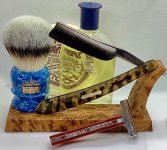
SOTD SATURDAY MORNING, MAY 29, 2022
Getting ready for the family barbecue at my place tomorrow. We’re expecting the usual crowd of 17, but planning for overflow (i.e. neighbors, significant others of grandkids etc.). I was hoping to have my TR6 ready. My littlest grandkids enjoy tooling around the neighborhood with G-Pop, but it’s just not to be this year! SWMBO doesn’t get it, and keeps telling me to be grateful that I’m here to celebrate it. She’s right, of course, but then again she usually is, as long as she steers clear of my wet-shaving hobby. That is sacrosanct and not open to discussion.
In any case, my mug shave this morning featured one of my absolute favorite vintage shavers, the Manhattan Cutlery 13/16. A friend, Scott (@DaltonGang), from the straight razor thread at TSD had been shaving with one and beginning to develop an appreciation for it. Mine was beautifully restored by David Work a few years ago, and arrived shave ready, although I have long since rebuilt the bevel. Shaving with this razor has always been a joy, as it was this morning! Three very smooth passes put the baby to bed and left yours truly’s mug wonderfully smooth.
Although I have always enjoyed shaving with either my original Enders Speed Razor or the later Durham Enders Speed Shavers, the blade hack using an original de-edged proprietary Enders blade as a shim, while adequate, was never consistently excellent. The Enders adapter has changed all that, and always ensures a consistently excellent shave, as was this morning’s. Two ATG passes sheared away my residual noggin stubble and left me with a pristinely smooth dome! I’m velveteen smooth from noggin to neck!
RAZOR: Manhattan Cutlery 13/16 (Mug), Durham Enders Speed Shaver (Dome)
BLADE: Schick Proline B-20 Injector (Dome)
PREP: Cold water rinse followed by a heavy scrub with Argan Oil
BRUSH: Simpson Chubby 3 Sovereign Fibre
SOAP: Mitchell’s Wool Fat
POSTSHAVE: Cold water wash with brush squeezings followed by a rinse with Humphreys WH. Finished with Canoe Original EdT AS Splash.
jgreenepa
TSC's "Velveteen Shaver"
It is sorta like riding a bike, although this morning’s shave was anything but as enjoyable and relaxing as I’d like. SWMBO in the absence of her grandchildren has decided that yours truly required the same kind of close supervision they receive when visiting. Since my discharge from rehab, my left wing isn’t quite as adept as my right necessitating a change in my straight technique. And by the way, I had practiced, minus the blade in my Tedalus, using only my right hand to straight shave the mug. The doc, of course, had informed me that my straight-shaving days were over. I smiled and nodded, but after 78 rotations around the sun, I’ll be damned if I let some wet-behind-the-ears kid tell me of what I’m capable. In any case, despite the bride’s concerns that I’d shear off an ear, all went well with only a very minor red spot on my left jawline. All in all it felt good to get back into the swing of things.
FRIDAY, Feb 21 SOTD
RAZOR: Tedalus (Mug), Durham Enders Speed Shaver (Dome)
BLADE: Feather Super (Mug) Schick Proline B-20 Injector (Dome)
PREP: Cold water rinse followed by a heavy scrub with Argan Oil
BRUSH: Simpson Chubby 3 Sovereign Fibre
SOAP: Mitchell’s Wool Fat
POSTSHAVE: Cold water wash with brush squeezings followed by a rinse with Humphreys WH. Finished with Pre de Provence Bergamot and Thyme.
FRIDAY, Feb 21 SOTD
RAZOR: Tedalus (Mug), Durham Enders Speed Shaver (Dome)
BLADE: Feather Super (Mug) Schick Proline B-20 Injector (Dome)
PREP: Cold water rinse followed by a heavy scrub with Argan Oil
BRUSH: Simpson Chubby 3 Sovereign Fibre
SOAP: Mitchell’s Wool Fat
POSTSHAVE: Cold water wash with brush squeezings followed by a rinse with Humphreys WH. Finished with Pre de Provence Bergamot and Thyme.
Attachments
jgreenepa
TSC's "Velveteen Shaver"
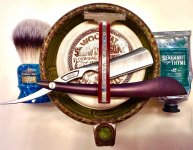
It is sorta like riding a bike, although this morning’s shave was anything but as enjoyable and relaxing as I’d like. SWMBO in the absence of her grandchildren has decided that yours truly required the same kind of close supervision they receive when visiting. Since my discharge from rehab, my left wing isn’t quite as adept as my right necessitating a change in my straight technique. And by the way, I had practiced, minus the blade in my Tedalus, using only my right hand to straight shave the mug. The doc, of course, had informed me that my straight-shaving days were over. I smiled and nodded, but after 78 rotations around the sun, I’ll be damned if I let some wet-behind-the-ears kid tell me of what I’m capable. In any case, despite the bride’s concerns that I’d shear off an ear, all went well with only a very minor red spot on my left jawline. All in all it felt good to get back into the swing of things.
RAZOR: Tedalus (Mug), Durham Enders Speed Shaver (Dome)
BLADE: Feather Super (Mug) Schick Proline B-20 Injector (Dome)
PREP: Cold water rinse followed by a heavy scrub with Argan Oil
BRUSH: Simpson Chubby 3 Sovereign Fibre
SOAP: Mitchell’s Wool Fat
POSTSHAVE: Cold water wash with brush squeezings followed by a rinse with Humphreys WH. Finished with Pre de Provence Bergamot and Thyme.
jgreenepa
TSC's "Velveteen Shaver"
Thanks, spent much of the last two years in rehab, but I’m back. Don’t expect I’ll be posting as frequently, but I’ll give it my best shot.Welcome back Jeff! I hope you are well.
jgreenepa
TSC's "Velveteen Shaver"
Thanks, Mark! Getting organized again slowly but surely.Good to see you back, Jeff!!
